It’s most common for us to see roses thriving in outdoor gardens, but did you know that it’s possible to grow these fantastic flowers indoors? As you would expect, growing roses indoors requires specific knowledge and a detailed care routine. This article will help you get started by introducing you to the best method for growing indoor roses.
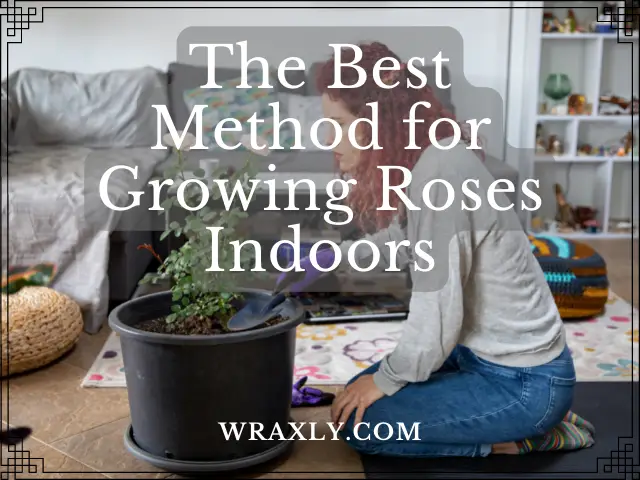
Table of contents
- How to Grow Roses Indoors
- Common Problems When Growing Roses Indoors
- Final Thoughts on How to Grow Roses Indoors
How to Grow Roses Indoors
Growing roses indoors is not as difficult of a gardening task as you might guess. However, there are a few key insights you need to pick up before you begin your indoor rose growing ventures. We’ve created a list of five steps that you should follow any time you want to grow a rose in your home, which are:
- Pick the right type of rose for indoor settings
- Set the ideal indoor environment for your roses
- Choose an excellent container for your roses
- Plant your indoor roses the right way
- Develop a care routine for your indoor roses
If you follow these five steps based on the guidance below, you should have no issue growing a rose in your indoor garden. Read on to equip yourself with all the information you need to start growing a rose garden in your house.
Pick the Right Type of Rose for Indoor Settings
Some rose varieties are better suited for indoor settings than others. Among the rose types best for indoor gardens, the most popular is the miniature rose. Unsurprisingly, mini roses have a smaller overall size, making them perfect for fitting into the limited space that an indoor growing setting often provides.
The minimal size of a miniature rose plant makes it an excellent choice for growing indoors, but there are plenty of other options as well. Many of the best choices maintain a smaller size and can tolerate the lower light exposure present in an indoor area. Here are a few rose varieties that you should try growing inside:
- Miniature rose, Rosa, spp.
- Fair Bianca rose, Rosa ‘Fair Bianca’
- Gruss an Aachen rose, Rosa floribunda ‘Gruss an Aachen’
- Passionate kisses rose, Rosa floribunda’ Passionate Kisses’
- Anthony Meilland rose, Rosa floribunda ‘Anthony Meilland’
- English rose, Rosa’ Darcey Bussel’
- French lace rose, Rosa’ French Lace’
- Princess Alexandra of Kent rose, Rosa ‘Princess Alexandra of Kent’
- Garden unicorn rose, Rosa’ Garden Unicorn’
Each of the ten roses in the list above survives in partial shade and grows to no more than four feet tall at most. Those two traits make these rose varieties better for indoor settings than roses that grow larger and require full sunlight. However, before you select one of the roses above, take time to study its distinct growing needs and its ornamental qualities to ensure you select the best rose for you.
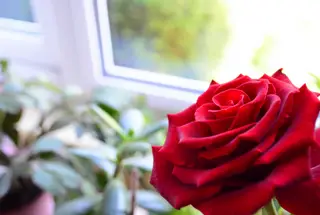
Set the Ideal Indoor Environment for Your Roses
By default, an indoor room will not have ideal conditions for growing a rose plant, primarily because there won’t be enough light. Instead, you’ll have to set the right conditions for your roses on your own. The next few sections will introduce you to a few of the key factors you should consider when setting up an indoor growing location for your roses.
Sunlight for Indoor Roses
Providing enough sunshine may be one of the most difficult aspects of growing roses indoors. If you are familiar with these plants, then you likely know that they show the healthiest growth and the best bloom characteristics when they live in full sun exposure. Naturally, an indoor setting usually gets less sunlight than an outdoor one.
While there’s usually less sunlight indoors, it remains possible for roses to survive there. The best approach for overcoming this challenge is twofold. First, you should select a rose variety that can tolerate lower light conditions, such as the ones listed in the previous sections. Second, you’ll want to place your rose in a room that gets as much daily light as possible.
Aim to put your indoor rose near a window that receives light for six hours of sunlight or more per day. Four hours or more of light per day may suffice, resulting in a less vigorous rose with unimpressive blooms. If you consistently find that your growing location needs more light, you can consider using a grow light. A grow light is an artificial light that will make up for what the sun cannot provide.
Also, although your indoor rose should be near enough to a window to receive bright indirect light for most of the day, it should not receive direct light from the window. Direct light from a window can cause several issues, including yellow leaves and scorch. To avoid this, place your rose next to a sunny window where they won’t experience direct sun rays for too long.
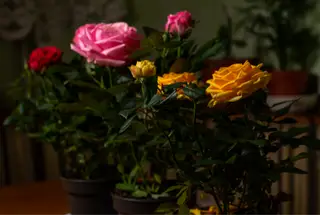
Temperature for Indoor Roses
Indoor roses also like to live in relatively warm temperatures. Generally, daytime temperatures between 65- and 75-degrees Fahrenheit will allow your rose to thrive. At night, it’s ok for the air temperature to drop a bit lower. However, it would be best if you did not allow it to dip below 60 degrees Fahrenheit.
Creating this warm temperature for your roses is often as easy as setting your thermostat to the ideal range. However, other factors can affect the overall warmth of your indoor rose-growing area.
Drafty windows are among the most common causes of cold indoor air, but nearby air conditioning units can make it too cold as well. Check to see if any such factors are present where you intend to grow your rose before you plant it.
Humidity for Indoor Roses
Roses that grow indoors will enjoy a relatively high humidity level. Humidity levels that fall between 50 and 60% will work the best. However, it can be difficult to achieve this level of air moisture indoors, especially during colder months or if you run heating or cooling units nearby.
It’s almost a guarantee that you’ll need to do something to change the humidity in your home before you can grow a rose successfully. One of the most common ways to achieve this is to mist your plants regularly. However, this is not a recommended approach for roses.
Misting roses can invite issues like rot, mildew, mold, and fungal infections, making your rose growing efforts short-lived. Rather than using mist, run a humidifier in the room where you grow your roses to ensure the humidity stays at the proper level.
Recommended Plant Humidifiers
| Image | Title | Prime | Buy |
|---|---|---|---|
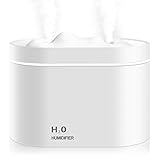 | 800ml Small Plant Humidifier, Auto Shut Off, Dual Nozzle Design, Super Quiet, White | PrimeEligible | Check Price on Amazon |
Top | Humidifiers for Indoor Plants, 500ml Cool Mist, (green) | PrimeEligible | Check Price on Amazon |
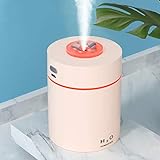 | Plant Humidifier, 240ml, Indoor Spray Humidifier (Pink) | PrimeEligible | Check Price on Amazon |
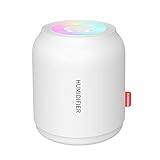 | Portable Small Humidifier for Plants, 260ml USB, Night Light Quiet Auto Shut-off | PrimeEligible | Check Price on Amazon |
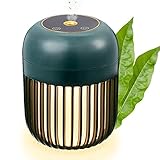 | Funland Indoor Mini Humidifier for Plants, 2000mAh Battery Operated, 4 Night Lights, Auto-Shut off, Green | PrimeEligible | Check Price on Amazon |
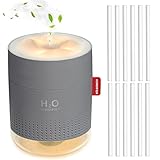 | Funland Mini Plant Humidifier, Indoor Cool Mist Humidifier with 10 Cotton Filter Sticks, Night Light, Auto Shut-Off, Quiet - Gray(500ml) | PrimeEligible | Check Price on Amazon |
Choose an Excellent Container for Your Roses
Setting up a perfect rose growing environment in your house is necessary but not enough to ensure your roses grow well. You’ll also need to pay special attention to the container you choose for your indoor roses.
An indoor rose container must have plenty of space to accommodate your plant’s root system. If your container is too small, your rose can quickly run out of growing space and become rootbound. Once your rose is root bound, it will decline as it fails to find additional soil moisture and nutrients needed for its continued growth.
FURTHER READING
- 10 Ways to Keep Cut Roses Fresh in Water
- 4 Quick Tips to Growing Roses in Pots
- How to Grow Desert Rose Indoors or Out
Good drainage is equally important for roses growing in indoor containers. Without drainage holes or some other way for water to filter out, your container will hold too much water and create waterlogged soil. Like many other plants, roses don’t perform well when their roots sit in excess water.
Lastly, it helps to choose a container that allows for air circulation. The soil in containers often heats and cools much faster than soil in the ground, which creates a volatile setting for your roses. With enough airflow, you won’t need to worry about the soil temperature rising or dropping too rapidly.
There are many containers you can use that meet those three needs. However, fabric grow bags often prove to be the best option for growing roses indoors. The materials of a fabric grow bag allow it to drain water effectively. In addition, the fabric lets the airflow into the soil and roots. These bags also do a fantastic job of preventing root binding through the process of air pruning.
Recommended Fabric Grow Bags
| Image | Title | Prime | Buy |
|---|---|---|---|
 Top
Top
Top
Top
Top
Top
Top
Top | Gardzen 10-Pack 5 Gallon Grow Bags, Aeration Fabric Pots with Handles | PrimeEligible | Check Price on Amazon |
Top | Wraxly Fabric Grow Bags - 7 Gallon Colorful Two-Tone Planter Pots. Best Gardening Gift for Plant Lovers! [5-Pack of Assorted Colors - Plus Black Bonus Bag!] | PrimeEligible | Check My Price on Amazon |
 Top
Top
Top
Top
Top
Top
Top
Top | VIVOSUN 10-Pack 15 Gallon Grow Bag, Reinforced Planter Fabric Pot for Gardening | PrimeEligible | Check Price on Amazon |
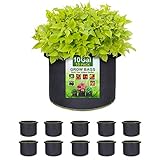 Top
Top
Top
Top
Top
Top
Top
Top | SunArea 10-Pack 10 Gallon Grow Bags, Thickened Nonwoven Aeration Fabric Pots with Reinforced Handles, Heavy Duty Plant Grow Bag for Gardening | PrimeEligible | Check Price on Amazon |
 Top
Top | VIVOSUN 5-Pack 20 Gallon Plant Grow Bags, Heavy Duty Thickened Nonwoven Fabric Pots with Handles | PrimeEligible | Check Price on Amazon |
 Top
Top | JERIA 12-Pack 5 Gallon, Vegetable/Flower/Plant Grow Bags, Aeration Fabric Pots with Handles (Black), Come with 12 Pcs Plant Labels | PrimeEligible | Check Price on Amazon |
Plant Your Indoor Roses the Right Way
If you adhered to the guidance in the previous sections, you are ready to plant your indoor rose. Here is an easy process to get your rose plant in your container the right way:
- Fill your container with a healthy soil mix
- Remove your rose from its original container
- Loosen the roots to encourage an outward spread
- Dig a hole in your container that is as deep as the root ball
- Place your rose in the hole and backfill while watering
- Prune any dead, damaged, or diseased stems and branches
There is some consensus that the best time to plant a rose is during the early spring or the late fall. But this advice is more applicable when you are growing a rose outdoors. By contrast, indoor settings are more consistent and less prone to seasonal weather changes. This means you should be able to plant your rose at just about any time of year if you follow the steps we’ve laid out.
Develop a Proper Care Routine for Your Indoor Roses
Once you establish a growing area and plant your indoor rose, your work is far from over. Now, it’s time to create a maintenance routine that you can follow to keep your roses in the best condition.
Watering Indoor Roses
Watering an indoor rose requires ongoing effort but is not a complex task. In most cases, if you give your rose water about once per day or once every other day, it will do well. When your rose is young, or if it experiences excessively hot or dry conditions for whatever reason, you may need to increase your watering schedule. Otherwise, watering roses once per day is a good rule of thumb.
HANDPICKED RELATED CONTENT: How Long Can Roses Go Without Water
Fertilization for Indoor Roses
Roses need a blend of all three main nutrients (nitrogen, phosphorus, potassium), and several micronutrients, including zinc, boron, calcium, and more. Of all the nutrients roses need, phosphorus is the most important as it promotes the best blooming characteristics for your plant.
You should apply your fertilizer at least three times per growing season. In some scenarios, a monthly fertilizer feeding will make for the best results for an indoor rose.
HANDPICKED RELATED CONTENT: 7 Best Rose Fertilizers
There are many kinds of fertilizers you can use for roses, including water-soluble and slow-release granular fertilizers. Regardless of which one you choose, make sure your fertilization schedule is both frequent and regular.
Recommended Fertilizers for Roses
| Image | Title | Prime | Buy |
|---|---|---|---|
Top | Down to Earth Organic Rose & Flower Fertilizer Mix 4-8-4, 5 lb | PrimeEligible | Check Price on Amazon |
 | Miracle-Gro Water Soluble Rose Plant Food, 1.5 lb | PrimeEligible | Check Price on Amazon |
 | Jobe’s, 04102, Fertilizer Spikes, Rose, 10 Spikes, Brown | PrimeEligible | Check Price on Amazon |
 | BioAdvanced 701210A 2-in-1 Rose & Flower Care 6-9-6, 10 lb. | PrimeEligible | Check Price on Amazon |
 | Scotts Super Bloom Water Soluble Plant Food, 2 lb - NPK 12-55-6 - Fertilizer for Outdoor Flowers, Fruiting Plants, Containers and Bed Areas - Feeds Plants Instantly | PrimeEligible | Check Price on Amazon |
 | Flower Fuel 1-34-32, 250g - The Best Bloom Booster for Bigger, Heavier Harvests (250g) | PrimeEligible | Check Price on Amazon |
Pruning Indoor Roses
Pruning your roses in the late winter months or early spring will help prepare them for the growing season ahead. During this time, you should focus on removing weak or dead branches. Eliminating these parts will help the rose focus its energy on creating new growth on the healthiest and most important stems and branches.
You should also prune your roses later in the growing season as well. During summer, after the flowers face, you should deadhead the spent flowers. Deadheading not only removes blooms that are past their peak, but it also encourages some varieties to bloom again.
Common Problems When Growing Roses Indoors
We cannot conclude this article without covering a few of the most prevalent issues that face gardeners who grow roses indoors. Below you will find some of the most common problems, with advice on how to deal with them:
- Drafts: Windows, heaters, air conditioners, and other appliances can create air currents that may harm your indoor roses. Drafts can make it both too cold for your plant and too dry. For the best chance of growing a healthy rose plant, pay attention to any drafts in the area and be sure to minimize the effect they have on your roses. But while strong drafts are to be avoided, good air circulation remains a must for roses if you wish to prevent powdery mildew and other infections.
- Pests: Indoor roses can fall victim to pest infestations, just like outdoor roses. Aphids and spider mites are some of the most common culprits, along with a few other insects. Thankfully, you can manage most of these problems by pruning or applying insecticide.
- Lack of light: The final and perhaps most obvious challenge when growing roses is a lack of light. If your indoor rose grows where it is too shady, it may have a weak growth habit and reduced blooms. Take care in choosing a growing location that gives your rose all the light it needs to look its best.
Now that you know about those potential rose-growing hurdles, you’ll be ready to combat them if they arise. Combining an understanding of these threats with the basics of rose care will set you on the right track to growing a beautiful rose plant in the indoor space of your choosing.
Final Thoughts on How to Grow Roses Indoors
The lovely petals of a rose plant are yours to enjoy if you know how to care for one of these plants. For those who hope to grow roses indoors, following this guide will be the best way to get started. Refer to the tips in the article above, and you’ll have a firm understanding of the most important elements of indoor rose care.

John Haryasz is a freelance writer and landscape designer. In the field of landscape architecture, he has contributed to many successful design projects throughout the country. As a writer, John specializes in creating captivating and informative web content. Through that work, he aims to share his design knowledge and promote engagement with the outdoor world.

![How to Water Indoor Plants [Plant Care 101]](https://wraxly.com/wp-content/uploads/2021/03/How-to-Water-Indoor-Plants-Plant-Care-101-1200-1024x576.webp)

![Growing Plants from Cuttings [A Simple Guide]](https://wraxly.com/wp-content/uploads/2021/03/Growing-Plants-from-Cuttings-A-Simple-Guide-1200-1024x576.webp)
